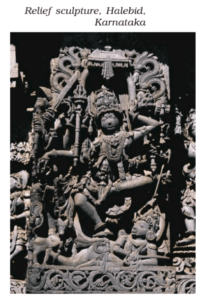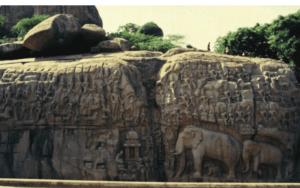Stone Meaning and Types of stone
Even today the stone carvers of Tamil Nadu begin with a prayer that first begs forgivenecess from mother Earth for cutting the stone. the prayer ends with offerings of sweets and milk to the earth and a solemn promise never to misuse or waste stone.

The stone cutter starts by locating a good quarry.then begins the process of cutting what he needs from the mother rock. metal pegs are hammered in a straight line into the rock at intervals. water is poured on to the rock to wet it. the change in night and day temperatures causes contraction and expansion and the rock gradually slits along the straight peg lines into perfect slabs.
The most Interresting part of the creative process is when the artist chooses the stone piece of work on. how does he decide which is the perfect piece of rock to use? what qualities of the rock does the artist look for …. colour or grain or texture, or the softness or hardness of the stone ? can he see” the image within the rock piece ? can he imagine what Its form will be or can he tell by touch how it will feel when it is completely carved ?
Types of stone
There are myriad varieties of stone to be found in India. soft soap contrasts with the hard granite. Igneous rock of the Decan. sedimentary rocks of the northern plains if India produce a variety of coloured sadstone’ and metamorphic rocks hardened over centuries under the soil form marble and limestone.
Rocks acquire their properties from minerals that give them colour. lustre and strength depending on how the rock was formed, igneous or sedimentary its molecular structure enhance it with a gain, layers and patterns. Each type of rocks, be it granite or sadstone, has Intrinsic qualities that the sculptor explores whe he creates a work of art.

the nature of the stone will determine how the sculpture is made and also its possibility soft soap stone allows for delicate intricate carving whereas sandstone a fragile sedimentary rock with layers of fine compressed Sands and grains has to be handled with extreme care as It Breaks easily within each category of stone there is enormous variety sadstone
ranges from golden yellow of Jaisalmer to the soft pitted and speckled stone of Mathura and Fatehpur Sikri the sculptors of India have been using this stones for the past 5000 years the differences in treatment of one stone from another in the hands of in artist can be seen in the time sculptures of mahabal Puram and the sandstone figures of Khajuraho hard granite stone was used in South Indian to make temples and household items like grinding stones the quality of stone available in each region of India style and form that can be created
Carving
Once the stone is selected the measurement for row having and cutting of the sculpture are takeon carving is a difficult process requiring skill concentration and extreme question it is a process in which form are cut away or subtracted from the original solid materials
Once the stone is selected the measurement for row having and cutting of the sculpture are takeon carving is a difficult process requiring skill concentration and extreme question it is a process in which form are cut away or subtracted from the original solid materials

Relief-sculptured panels:- A relief has curving only on one side the curving can be Shallow or deep while the other side is Flat and is usually embedded into the masonry work of the building are low relief can be 1-3 CM Deep and high relief can almost look like a three dimension sculpture
Three-dimensional figures:- such figures can be viewed from all sides they can also be used to create free standing pillars like those erected by Ashoka throw out his empire in the third century BCE
Stone Sculpture through the Ages
At Bhimbetka in madhya pradesh, there are a number of rock shelters of the stone age period. early inhabitants lived in natural caves and created fine tools and flints of agate and other natural stones in the area. these tiny flints and well-carved stone implements are the first exampples in the long story of Indian sculpture.

At Ellora. in maharashtra there are hindu. Buddisht and jain rock-cut shrines. the kailash temple at Ellora of the ninth century is an entire temple that was carved out of the natural hillside. the temple is really a massive sculpture cut out of a single piece of the hill the artists started work from the top and carved downwards. beginning with the towering roof. the windows. the doors through which one enters into halls with enormous sculptures panels.
Conclusion
Read the article carefully and after that you can get the overall knowladge about stone and if you face any problem in this article so you can tell me in the comment box I will prove you solution .